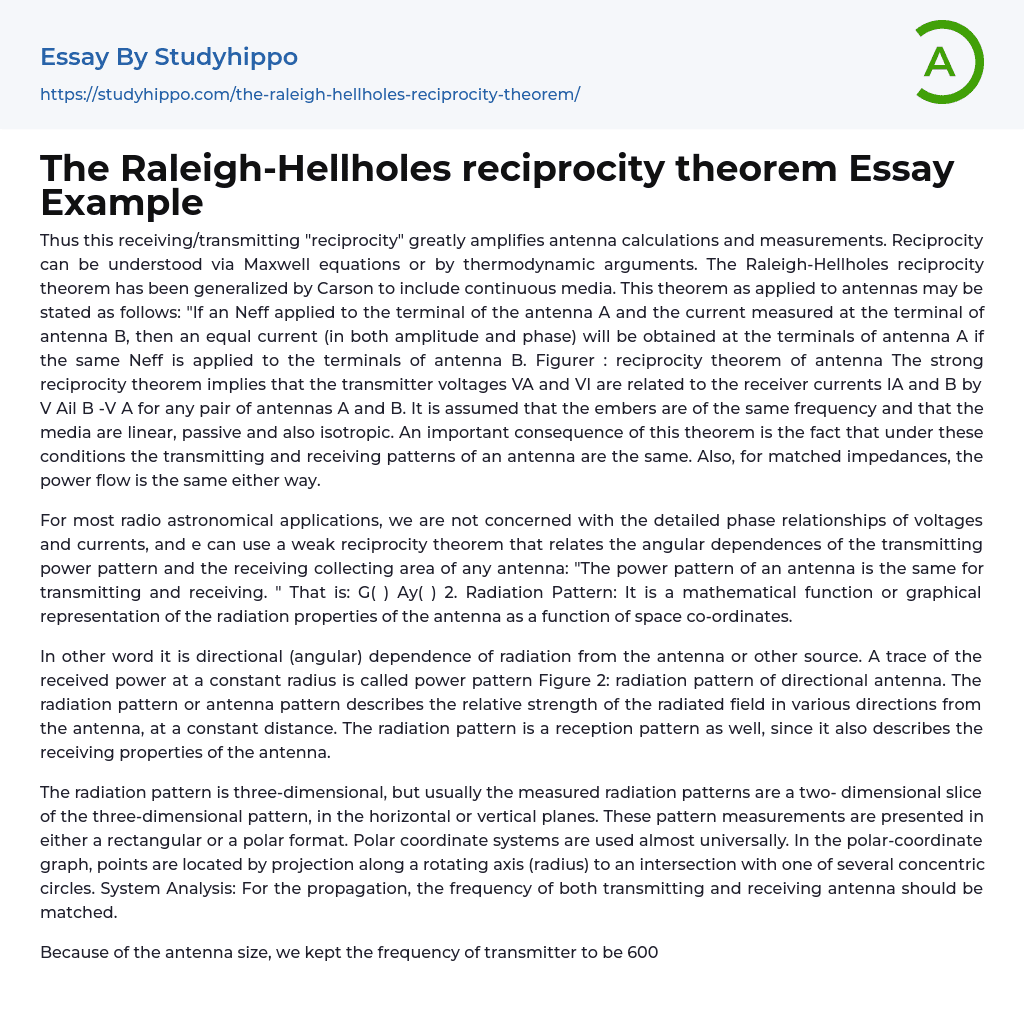This text emphasizes the concept of reciprocity in antenna calculations and measurements. Reciprocity in this context can be understood through Maxwell equations or thermodynamic arguments. The Raleigh-Hellholes reciprocity theorem, generalized by Carson to include continuous media, states that if an Neff is applied to the terminal of antenna A and the current is measured at the terminal of antenna B, then applying the same Neff to the terminals of antenna B will result in an equal current (in amplitude and phase) at the terminals of antenna A. The figure illustrates the reciprocity theorem of the antenna. The strong reciprocity theorem states that the transmitter voltages VA and VI are linked to the receiver currents IA and IB for any pair of antennas A and B. This theorem assumes that the embers operate at the same frequency and that the media are linear, passive, and isotropic. An im
...portant implication of this theorem is that, under these conditions, an antenna's transmitting and receiving patterns are identical. Additionally, when impedances are matched, power flow remains consistent in both directions.
In most radio astronomical applications, we do not need to worry about the intricate phase relationships between voltages and currents. Instead, we can utilize a weak reciprocity theorem that connects the angular dependences of the power pattern when transmitting and receiving with the collecting area of any antenna: "The power pattern of an antenna remains consistent during both transmitting and receiving." In other words, G( ) Ay( ) 2. The radiation pattern is a mathematical function or graphical depiction that showcases the antenna's radiation properties in relation to spatial coordinates.
The radiation pattern of an antenna or other
source refers to its directional (angular) dependence. The power pattern, which is a trace of the received power at a constant radius, is also called the radiation pattern of a directional antenna (Figure 2). It describes the relative strength of the radiated field in different directions at a constant distance. Additionally, the radiation pattern serves as a reception pattern, as it also describes the antenna's receiving properties.
The radiation pattern is typically measured as a two-dimensional slice of the three-dimensional pattern, either in the horizontal or vertical planes. These measurements are usually presented in either a rectangular or polar format. Polar coordinate systems are widely used for this purpose. In a polar-coordinate graph, points are located by projecting them along a rotating axis (radius) until they intersect with one of several concentric circles. In order for the propagation to be effective, the frequency of both the transmitting and receiving antenna must be matched.
Due to the size of the antenna, the transmitter's frequency remains at 600 Maze. This gives us a wavelength of 0.5 m or 50 cm. Initially, the input power for the directional antenna is set at 110 db, but we have included a 20 db attenuator at the input point to reduce some of this power. On the receiver side, we measure the received power for both omni directional and directional antennas across angles ranging from 0 to 360 degrees with increments of 5 degrees. These measurements allow us to determine the radiation pattern in the azimuth plane, which is similar to a top view observed from above like that seen by a bird.
- Energy essays
- Density essays
- Thermodynamics essays
- Motion essays
- Atom essays
- Sound essays
- Electricity essays
- Nuclear Power essays
- Temperature essays
- Physiology essays
- Light essays
- Force essays
- Heat essays
- Speed essays
- Big Bang Theory essays
- Energy Development essays
- The elements essays
- Voltage essays
- Solar Energy essays
- Nuclear Energy essays
- Alternative Energy essays
- Melting essays
- Nuclear Family essays
- Auto Racing essays
- Classical Mechanics essays
- Harley-Davidson essays
- Rail Transport essays
- Suzuki essays
- Tata Motors essays
- trucks essays
- Vehicle Brands essays
- Agriculture essays
- Albert einstein essays
- Animals essays
- Archaeology essays
- Bear essays
- Biology essays
- Birds essays
- Butterfly essays
- Cat essays
- Charles Darwin essays
- Chemistry essays
- Dinosaur essays
- Discovery essays
- Dolphin essays
- Elephant essays
- Eli Whitney essays
- Environmental Science essays
- Evolution essays
- Fish essays




